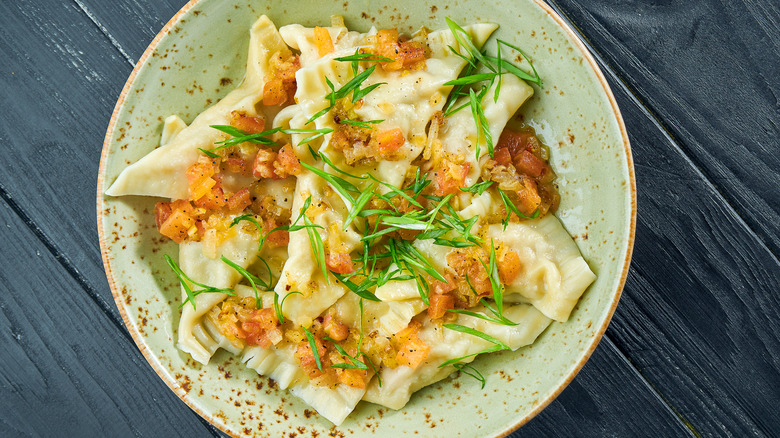Why Triangular Foods Are Important During Purim
Purim is a celebration commemorating the deliverance of the Jewish people of ancient Persia from the scheming minister, Haman. The story is one of intrigue and divine intervention, ending in Haman's execution after the disguised Queen Esther reveals his plan to destroy the Jewish people. The celebration consists of reading Esther's scroll, distributing food-laden gift baskets, giving charity, and having a feast. And, of course, it includes the familiar triangular Purim cookies.
Their namesake, Haman, is said to have inspired their shape with his three-pointed hat. Also called oznei Haman or Hamantashen — respectively Hebrew and Yiddish for "Haman's ear" and "Haman's pocket" — consuming these triangular artifacts is symbolic of foiling the minister's plot. However, the significance of triangular foods on Purim goes a lot deeper than just Haman. Combined with the stuffing that's "hidden" inside, it pays homage to Esther's covertness and the secret hand of God.
And talking to stuffing, the versatile Hamantashen are traditionally filled with poppy paste, but a variety of sweet and savory fillings such as fruit jelly, dates, nuts, chocolate, cheese, and even meat. Hamantashen are sometimes filled with another holiday staple — traditional Jewish brisket. Food is a significant component of most Jewish celebrations and is particularly important during Purim. The scroll of Esther, on which the celebration is based, mentions the word "feast" over a dozen times, making the Purim Feast, and all the significance it holds, central to the celebration.
Triangular Hamantash cookies are linked to Haman and more
Hamantashen are flaky, buttery, shortbread-like cookies with a delicious filling of dried jam. The name's reference to his pocket is also seen as an allusion to him lining his pocket with bribes. Another (particularly gruesome) explanation is that the cookies signify Haman's ears because they were apparently clipped off after his execution. While visually vivid, there seems to be no textual support for these explanations in the original scroll.
The three-pointed shape of Purim cookies is also said to signify the three patriarchs of the Jewish faith — Abraham, Isaac, and Jacob — who helped bolster Esther's resolve to deliver the Jewish people. Interestingly, the "tash" in Hamantashen can be taken as the Hebrew word for "weaken" and could again refer to Haman's downfall. Therefore, it is not just the similarity to triangular hats, ears, and pockets but also an allusion to the three founders of the Jewish faith and the role they played in the story of Haman's defeat.
However, there is no escaping the fact that the triangular cookies are named after an antagonist, and eating them is a sign of victory over him. This theme of metaphors combined with frivolity runs through Purim celebrations, which also includes wine (often Kosher wine) as part of the feast called se'udat Purim.
Triangular foods, hidden fillings and the Purim feast
While Hamantashen is the most popular three-pointed food at the Purim feast, other triangular foods are also featured during its course. Meat-filled dumplings called Kreplach, also seen during Yom Kippur and Hoshanah Rabbah, are regularly made in a triangular shape. These delicate dumplings, usually stuffed with ground beef and served in a soup, resemble many eastern European-style dumplings.
Another popular three-sided food is Bourekas — a stuffed puff pastry filled with cheese, potato, or meat. The significance here is not just in the shape but also in the fact that this dish is stuffed. The idea of foods with "hidden" fillings is said to pay homage to how Esther disguised or "hid" her Jewish identity in the story of Purim. As it goes, she ultimately reveals her faith to the king in the process of also revealing Haman's dastardly plot against the Jews, leading to the corrupt minister's execution.
One final significance of stuffed foods (remember that even Hamantashen are technically stuffed cookies) is the hidden presence of God. The scrolls of Esther, on which Purim is based, do not explicitly mention God despite the story's underlying basis being divine intervention. Once again, what is hidden is important, much like the delicious stuffings in the triangular Hamantashen, Kreplach, and Bourekas you enjoy during Purim.


